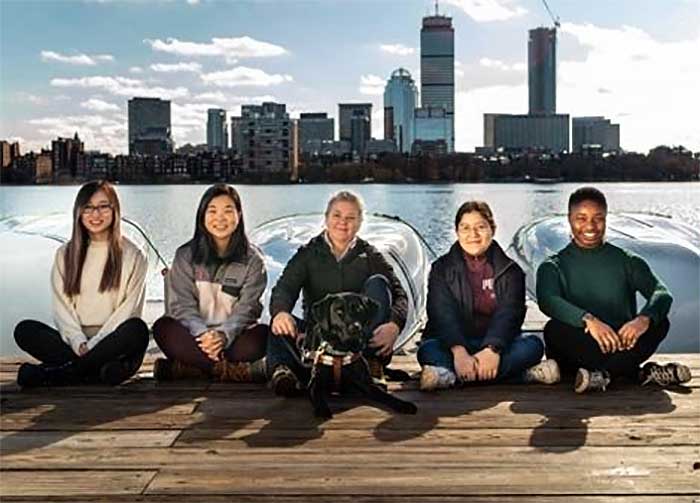Advertisement
A team of MIT engineering students have created technology that allows a blind sailor to get back to the sport she loves.

Pauline Dowell (center) and her guide dog, Dora, hang out near the Charles River with MIT students from Team Pauline: (from left) Sandy Yang, Tiffany Xi, Rebecca Agustin, and Temitope Olabinjo. (Photo: Lillie Paquette)
Pauline Dowell loved sailing competitively in college, despite her impediment of being born with limited vision. Her vision only deteriorated after college and, now legally blind, she gave up sailing.
"As soon as work was over I'd go home. Because I didn't have a cane, I didn't know how to get around. I'd walk into things. I'd fall down stairs. Just going out was traumatic," she told MIT News, the school news source for the Massachusetts Institute of Technology, where she now works. "So I'd stay home. A lot of blind people just stay home. They edit themselves out of life."
Luckily, working at one of the top colleges in the nation proved fortuitous for Dowell.
Sailing is a sensory experience, but how can you sail blind? How do you continue to sail if you can't see those things that the rest of us take for granted? Although audio compasses, which use beeps of different pitches to give accurate course information for visually impaired sailors, have been around for years, there has never been anything to assist blind sailors in trimming their sails for best effect — until now.
Four students from the MIT School of Engineering have developed technology that lets blind helmsmen know if the air is flowing smoothly and correctly over a sail. Sighted sailors rely on the low-tech telltales sewn to their sails.
Advertisement
The students, all seniors enrolled in MIT's Principles and Practices of Assistive Technology program, came up with a solution. After a couple of prototypes, the device the students came up with a telltale that Dowell could hear. The team engineered a sensor shaped like a sheath that surrounds each of the four telltales. When a sail is correctly trimmed, the telltale should stream aft. But if the sail begins to stall or the telltale flutters, it contacts a sensor on the interior surface of the sheath, which triggers a variety of audio warnings that can be heard in an earpiece worn by Dowell, allowing her to make corrections to sail shape or boat trim.
The prototype device was fitted to Powell's Beneteau 36 sailboat, Konik-Morski, Polish for "seahorse," which she lives aboard with her guide dog, and sailed in a singlehanded race from Marblehead to Provincetown, a trip of some 60 miles across Massachusetts' Cape Cod Bay, although she did take along a friend to keep an eye out for navigational hazards and other boats, but who otherwise had no part in the sailing.
The four students from Team Pauline, as they call themselves, hope their invention will be commercially developed, making it available to other sailors with restricted sight. Since fitting the device to her boat, Dowell has heard from other blind sailors interested in the technology.
"Blind sailors really want to be able to handle the boat without having to rely on a lot of people," she said.
Read the full report in MIT News
